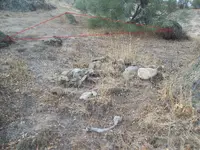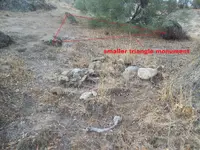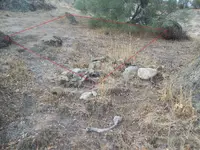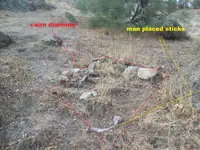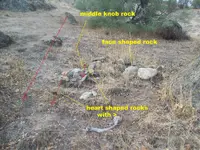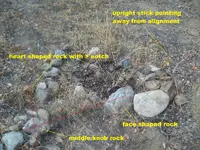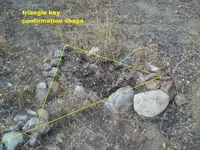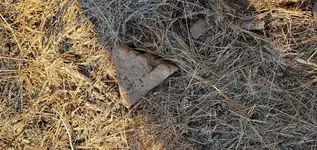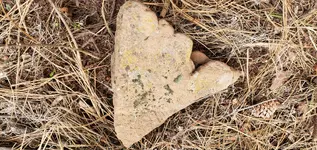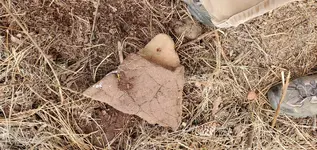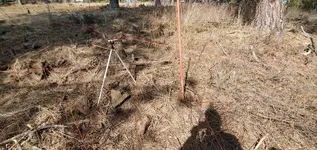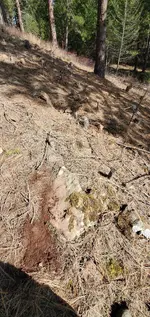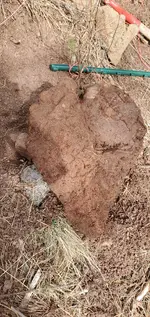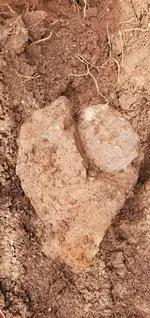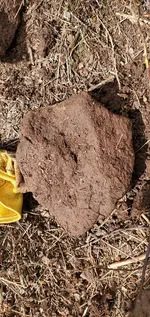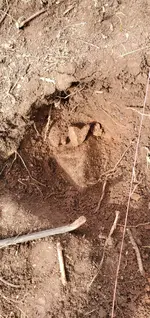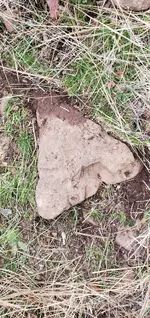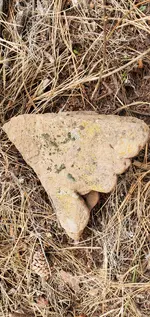Prefer to earn treats; not give them away. Pearls before swine, ect... (not calling anyone a swine). The triangle monument seems to be located at a junction site, an area near (upper bank on trail) the trail or on the trail itself. This is the last spot they (spanish, th, sentinels) visit before heading towards the end point.
Most often, this monument type (triangle) provides one or more direct line of sights to its nearest end points. This triangle monument is not for pinpointing. But it will take you on a straight line directly
towards the end point it is related to. It will not tell you where to stop or how far to go. Once you get close to the end, you will then use different alignment boulders (these ones usually under 200ft from end point and for end point confirmation (plus some extras for misdirection)). Although dont
be suprised if some of those seemingly extra misdirection boulders actually lead to other nearby vaults.
In some areas I have seen single alignment boulders connect to multiple storages (added a new alignment boulder nearby a previously existing alignment boulder but pointing in a different direction).
The 500ft max came from Sandy, which I have proven in the field to be correct time and time again; for the record Sandy is the only one that i know of whos info is 100% correct. I determined that % by incorporating his info at my own private sites.
500ft is pretty common for max alignment line of sight during 1500-1600s. In some rarer cases, came across late 1700s alignment boulders (100-200lbs, smaller ones) that were related to vaults within 200ft of them but ALSO gave a direct
line of sight to a storage in the back of the canyon over 750ft away. There were other monuments and alignment boulders used closer to the storage to confirm end spot.
Now onto the Tri Monument from HT55.
Anytime I have came across a triangle monument, one leg (occasionaly 2 legs) provided a direct line of sight to its intended end point(s). The same applies to the diamond shape. The triangle is a diamond cut in half.
This principal also applies to shadow triangles and shadow diamonds that are collagued
with major monuments and/or hidden near eye catchers. Shadow triangles/diamonds are usually within 50ft max of the end point, usually much closer. Some ancient ones max 500ft.
Think hidden in plain sight or something that stands out sitting next to something that does not. After you see something, and look closer, then the other becomes visable. (same rule applies to confirmations).
example; a large obvious rock which is an alignment rock but no obvious animal or other shape from any angle, may have its confirmations in the shadows.
Confirmations are required to verify relativity!!
Alright, onto pic analysis. There are 2 triangle monuments, a larger and smaller one. They are each highlighted in Red. You will have to determine which of the lower legs is the correct line of sight alignment since
there is a slight deviation between the two (obviously, for confusion, misdirection)
The upper triangle monument boulder has a side face profile Shadow silhouette which looks to the left along the alignment direction. (go left confirmation) (spanish monument boulder confirmation)
The sentinal or th triangle that makes up the pile of rocks at the lower end of pic includes an exact
copy of the spanish triangle monument alignments.
See the small heart shaped rock at the far left side of the pile, with its own > sign confirming alignment direction? That one
seems to be the most recent addition since its counter part which came before it is harder to see and located a foot to its right (also drawn in Red).
Both of these cairn alighments have a heart shaped rock at opposite ends and both rocks have a > notch which is open towards the alignment (direction confirmation) (man made heart rocks confirmations)
There is a face shaped rock (it is one of the two largest rocks in the pile, the large white rock next to it being the eye catcher to something less obvious next to it) on the lower cairn pile of rocks, it is 1 of 2 cairn alignment rocks that point to the left. The face shaped rock
also looks to the left, the same as the shadow silhouette from the upper boulder of the spanish triangle monument above. The 2 of 2 cairn alignment rock is the middle knob rock. The middle
knob rock is used to confirm both alignment directions since it connects to the heart shaped rock with > sign and the side face profile rock.
Notice how this cairn alignment pattern copies the above spanish monument alignment pattern and yet is still well hidden in plain sight.
Notice the small stick someone set upright out of the ground on the far right side of the small rock pile. Turn that stick 180 degrees and it points on the alignment. It currently points away from it.
How about the larger stick at the lowest end of the small rock pile? it points in the same direction and the 2 small rocks nearest to it confirm its part of the cairn feature. Furthermore, that stick and rock make the
cairn into a diamond shape; again copying the larger monument pattern (a triangle, with an added lower point to make a diamond).
Pics added to help visualize.
Did you try hard?

Well, TriHarder next time...
 View attachment 1910669
View attachment 1910670
View attachment 1910671
View attachment 1910672
View attachment 1910673
View attachment 1910669
View attachment 1910670
View attachment 1910671
View attachment 1910672
View attachment 1910673
photo below shows the other main alignment, heading downward or towards area below photo
3 red line alignments (1 spanish on far left, 2 th or sentinel with heart > notch rock)
View attachment 1910674
View attachment 1910675
View attachment 1910676



 Well, TriHarder next time...
Well, TriHarder next time... 
